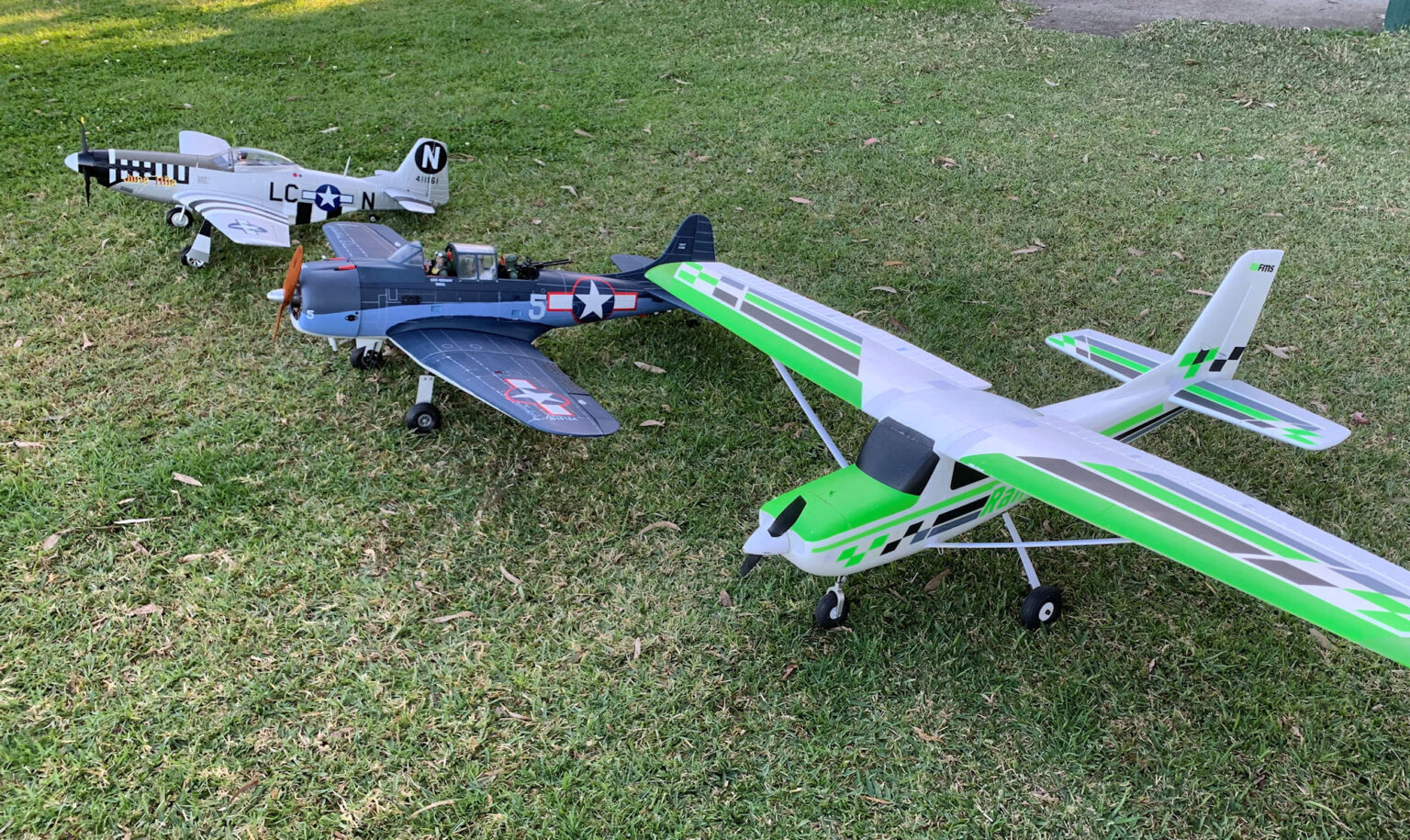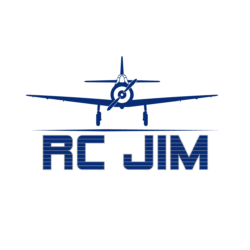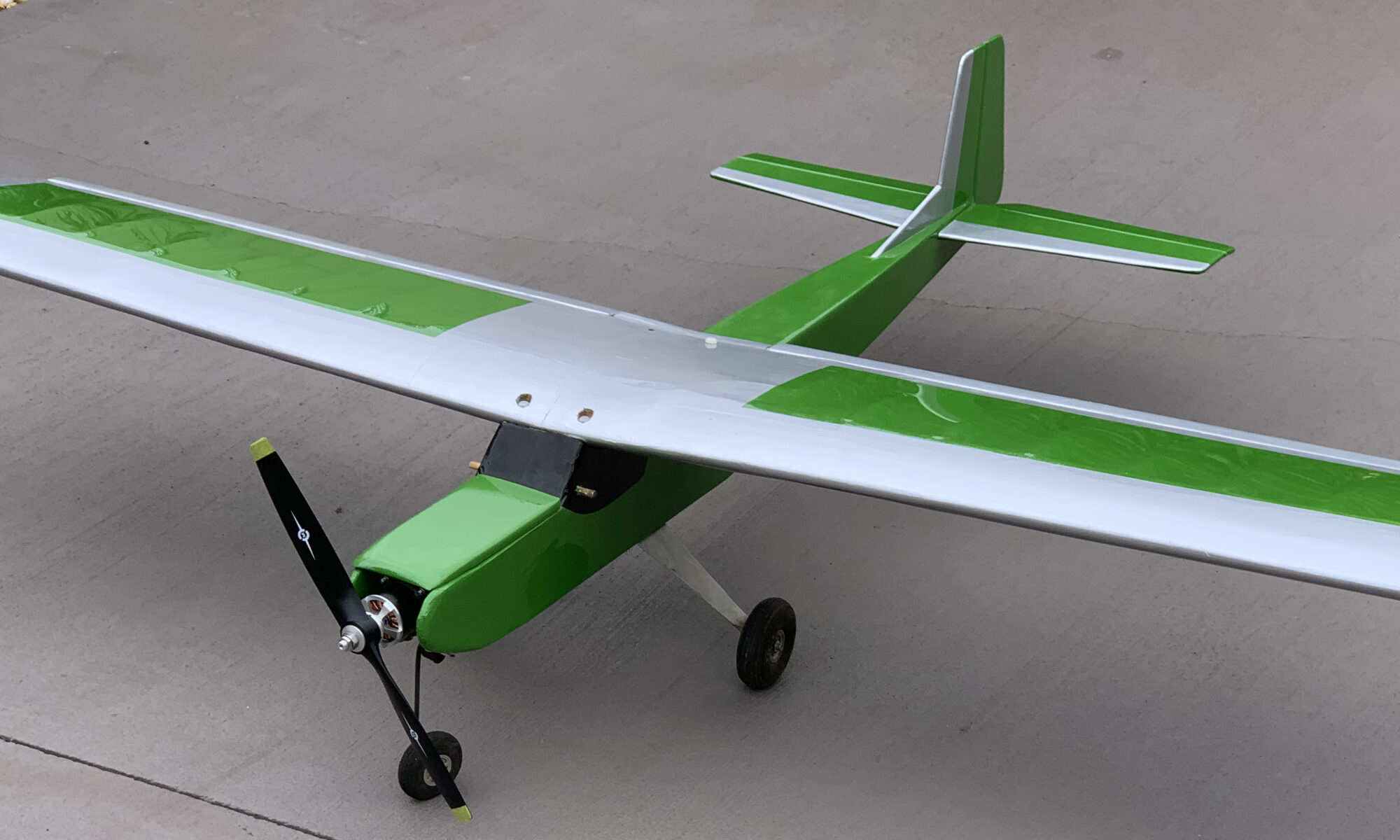How to select an electric motor power combination to replace a glow fuel engine in a radio controlled model plane.
Information needed
Given that you are re-powering an existing plane, it’s important to make sure that you get a new power setup that is right for that particular aircraft. So, begin by taking note of the following information:
- Anticipated weight of the completed aircraft with battery. Take out the old engine and fuel tank and weigh the plane. For a typical ’40 size’ plane, add 550 grams (1.2 pounds) for the electric motor, a 4s battery and an ESC. That will get you started.
- Space available for the battery. A 4s battery should easily fit in an area suited to a 12 ounce fuel tank – just about as long, and a bit skinnier. The skinnier part is good, because you may need to place the ESC adjacent to or under the battery. Going to a 5S will mean a slightly longer battery – so check before you buy!
- What is the maximum prop diameter that can be used? Certainly, what you had on it before should be fine. Many electric motors like larger props, and they are more efficient, so consider whether or not there is enough ground clearance to go up a notch on prop size. For a ’40 size’ plane, about 50 mm (2 inches) clearance between the prop and the ground should be fine. For a tail dragger, make sure to position the plane in a level flying attitude while measuring. With tricycle gear you may get by with a little bit less if the nose gear isn’t too flimsy. How flat the ground is on your field, and how long the grass is will also make a difference.
- What type of flying do you plan to do? Most often, it will be “sport” flying. That includes doing basic aerobatic manoeuvres, such as loops and rolls, but not sustained knife edge flying or hovering. Those would be considered “3D” flying.
- If you are considering getting “budget/generic brand” components, then your brand of receiver may come into play.
Basics to Understand
Electric motors have a variety of numbers that describe them. First of all, the typical four digit number will give you the diameter and length of the motor in mm. The diameter may be either the case diameter or the rotor diameter, and similarly, there can be different parts of the motor that are referred to in the length. But, the first two digits are the diameter, and the second two are the length, and bigger ones give you more “oomph.” The other main thing you will generally find in the model number is the “kv”. That’s not kilo-volts, nor is it the amount of power delivered. It’s how many RPM are developed by each volt of electricity supplied to the motor. Keep in mind, that if you are going to use a 12 inch prop, you are going to need to spin it fast to get the thrust that you need, and that will mean a high kv number.
Related to the kv, as you go up in the number of cells in your battery (the “S” number), the voltage is going up, giving you more RPM. But it also means more weight! A 6S battery is quite a chunk, so if you are going for an easy to fly 40 size plane, you might want to stick to four or five cells.
There are other important factors that are helpful to know, so if you are new to brushless DC motors in aircraft, I would recommend that you watch our video: “All About Electric RC Planes.”
Selecting the motor
Right off the bat, things get a bit dicey. What we would like to do, is see a chart of motor data which includes thrust for various recommended props for each motor, go down the list, find the ones which have a thrust a bit more than the weight of a plane, then from among those, select one that can develop that thrust with a prop no larger than what our plane can handle.
With Cobra motors you can pretty much do that (Cobra website) – albeit, having to go through multiple charts. Also, they tend to be rather expensive, and are not necessarily better than other brands. And, I have found that each brand will have performance gaps. What you really want may be somewhere between the two nearest choices, and that difference may be a real issue. So, you may find that one brand has what you need, but not another brand.
So, as I look through the “sponsored” items with photos across the top of the search results, I see a Dualsky 40E tuning combination. That might work, but I want to replace a 46, so I see there is also a 50E, so I have a look at that. Following the link I go to that hobby shop’s listing, and see that they have the spec sheet for the motor there. It’s a Dualsky 4120C-V2 and it’s available with 560 to 350 kv. At the bottom of the sheet, I see that it is supposed to be suitable to replace a 46 to 50 two stroke engine, so that’s it! Or is it? Going up a row I see it needs a prop that’s at least 13 inch diameter, and generally with props you want to have the flexibility to move to different sizes, and with this there may be no wiggle room.
By the way, when you look at the manufacturer’s spec sheet, it will show you all the variations that are available for that motor, but the tuning combo will just be for one of them. You need to look at that one in particular.
Backing off, I figure that it might be worth considering the 40E. After looking at a couple of links I find the manufacturer’s spec sheet. The tuning combo uses the 820 kv motor, but it is available with 1020 to 519 kv. I note that the higher kv motors work with smaller props (13x8E to 15x6E for the 820 kv motor) , and the larger kv motors require larger props, but pull more watts. Watts are like horsepower. 1 HP = 746 Watts. I happen to also know that OS says that their OS Max 46 develops 1.65 HP, and I believe that the Watt ratings for electric motors are input power, not power delivered. So, it would seem that I ought to be targeting something well over 1200 Watts. However, given that they say this motor is equivalent to anything from a 32 to a 40, the OS 32 is claimed to have 1.12 HP. That’s 830 Watts. The spec chart says that the 820 kv motor draws 1040 Watts. So, that may be better than a 32, but it’s well short of the 46.
Next, I do another search and discover the Eflite Power 46, 670 kv. That is targeted specifically as a 46 replacement. It can be used with either a 4S or 5S battery, and with a 13x8E prop and 4S battery it pulls 670-745 Watts. It’s rated at up to 800 Watts, but the 5S battery might well pull it up over that with the 13 inch prop. But with the higher voltage, the prop would be spinning faster, and a smaller prop could be used. Unfortunately, we don’t have any data on that option.
I then begin to widen the search by looking at what each of my selected manufacturers have on offer beyond the tuning combos. Scanning through a list of their motors, Spektrum Avian 4260 800 kv looks like a viable option. 5-6S, recommended for up to 7.5 pound planes with sport flying or 5 pound planes for 3D, a 46 equivalent. 10×5 to 11×5 props. 1350 watts (burst). The higher kv allows the smaller props. This sounds more like what we are after. It would require a 60 amp ESC, and I’d probably start with the 5S battery, allowing something closer to my targeted 12 inch prop and keeping the weight down.
Looking at the Cobra motors, they have some good options for larger and smaller planes, but I struggled to find something that was a good fit for a 46 equivalent with a relatively small prop.
Testing the motor
Given that you are not using a complete combination of motor, ESC and prop provided by the manufacturer, it’s important to test what you have chosen to make sure the amps are within the manufacturer’s specifications. Spending all that money, you don’t want it going up in smoke on your first flight. So, when you buy the motor and other gear, also pick up a watt meter. Set up the plane on a bench, safely secured, and crank up the motor to full throttle, or until you hit the “burst” amps level. What the manufacturer specifies as the “burst” amps is typically what the motor can handle for about 15 seconds without melting the windings. If the amps are too high, then you need to go to a smaller prop. If they are lower, then you can move to a larger diameter or higher pitch on the prop to get added thrust. If you want to really know what’s going on, purchase a luggage scale, and use it to measure the thrust. For sport flying that should be a little over the weight of the plane, including battery. For details on how to do this, see our video: “Electric RC Plane Motor Testing.”
Final checks
Before placing your order, check the following:
- Are there a variety of recommended props that will suit the ground clearance requirements?
- Check the dimensions on the battery(-ies) that you are going to order. Will one fit in the plane with room for an ESC?
- Check that the Amp rating on the ESC is well above the maximum burst amps specified for the motor.
When you receive the items:
- Install them all in the plane and check the balance point. Adjust battery/motor location and/or add ballast to bring the fore-aft balance within specifications, and side to side balance reasonably even.
- Calibrate the throttle and program the ESC. See our videos: “Introduction to ESC Programming for RC Planes” and “ESC Programming – How to Do It.”
- Set up the plane to safely check the amps drawn, and run a test using a fully charged battery. Change props if necessary.
Feedback
I’ve written this article, and expect to do a related video, because of a question from one of our YouTube channel subscribers. It may be that your question will prompt something similar. My goal is to help you to enjoy your hobby even more by helping you to learn and grow in what you do. Some of you are well ahead of me, and you may be able to instruct me in certain areas, so whatever your situation might be, get in touch. You can use the contact form on the website, or respond to the specific video on YouTube. As always, happy flying!


